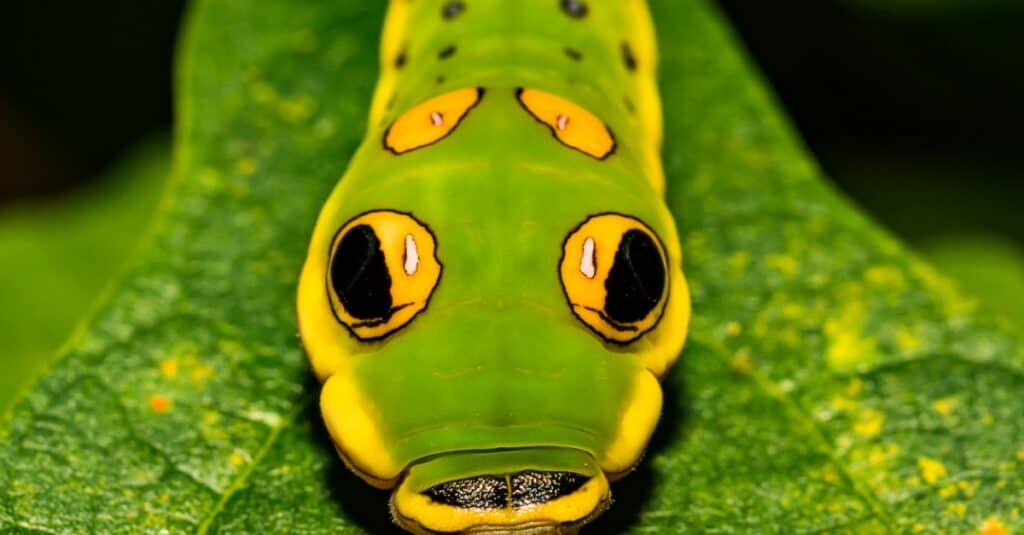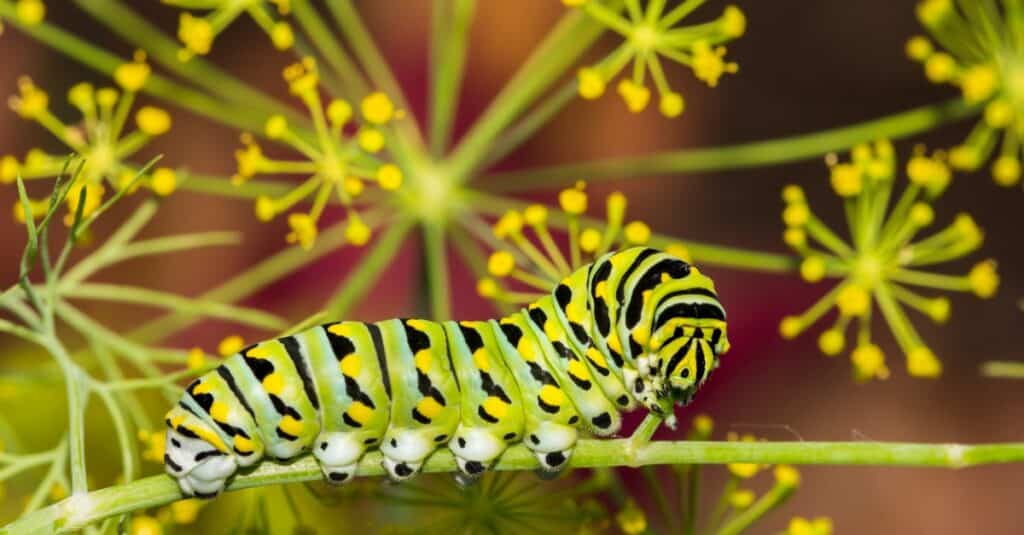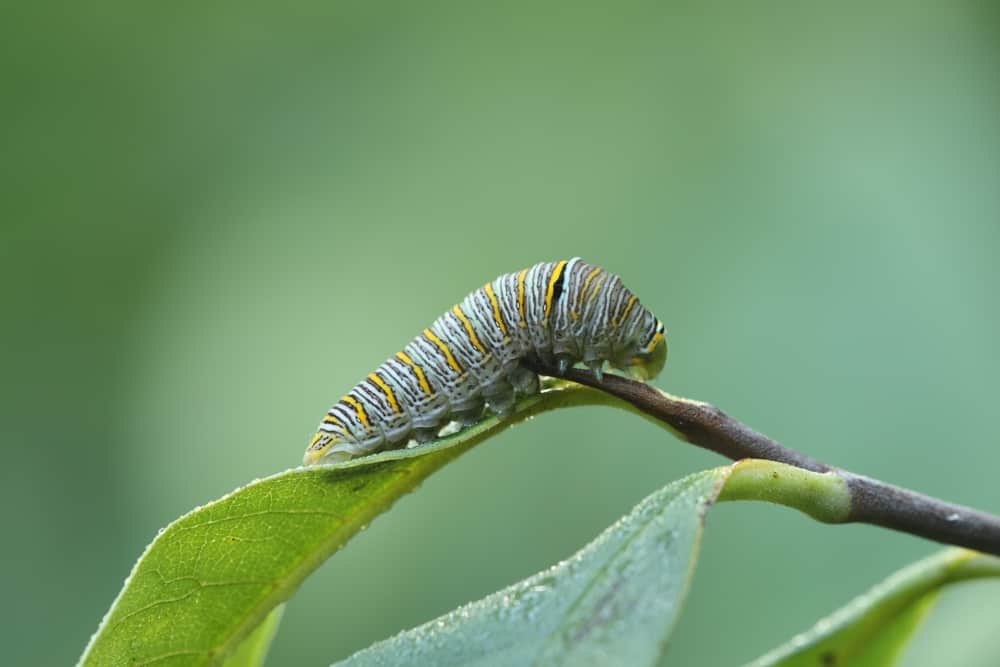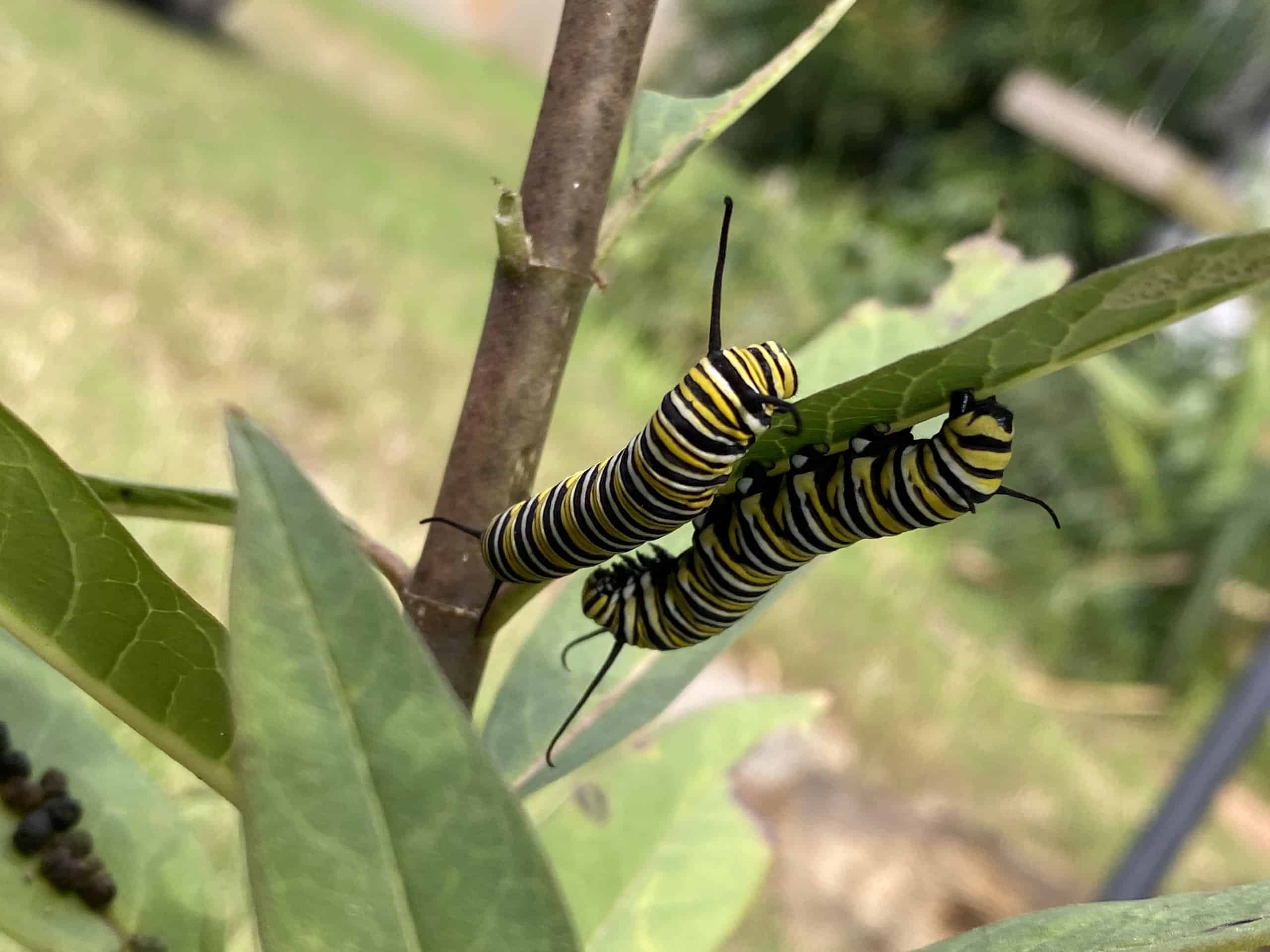
There are close to 560 species of swallowtail butterflies.
©iStock.com/JasonOndreicka
Have you ever seen a swallowtail butterfly? They’re magnificent and strong!
Swallowtail butterflies get their name from their long tail. It extends from their hind wings. The tail serves as a diversion, getting birds to look at the butterflies tail instead of its head.
Certain species of swallowtail also protect themselves by being distasteful. As caterpillars, they feed on poisonous plants, so they won’t be an appealing snack to predators. There are close to 560 different species of swallowtail butterflies, and they all have unique diet habits.
What do swallowtail caterpillars eat? Read on to find out.
What Do Swallowtail Caterpillars Eat?

Swallowtail caterpillars eat plants like citrus, carrot, custard-apple, olive, magnolia, and birthwort.
©Jay Ondreicka/Shutterstock.com
Swallowtail caterpillars eat plants of the birthwort, citrus, carrot, and custard-apple families. Young caterpillars also eat magnolia, olive, laurel, and rose families.
Swallowtails belong to the family Papilionoideae. They are known for having large, thick bodies.
What Does a Swallowtail Caterpillar Look Like?
Swallowtail larvae survive by resembling bird or lizard droppings. Certain species have the advantage of having rows of blue spots on the abdomen. These are known as fleshy tubercles.
Older larvae have enlarged thoraxes and eye spots that aid in survival. Some swallowtail caterpillars even have a defensive gland called the osmeterium.
The defense gland sits directly behind their heads. It’s hidden from view and vibrant colored.
Differences in Diets for Swallowtail Caterpillar Species
The world is full of all sorts of swallowtail butterfly species! That means when the time is right, plenty of swallowtail caterpillars are searching for food. The species have slightly different diets, which their preferred host plant can see.
Pipeline Swallowtail Diet
Moving on, let’s discuss the pipeline swallowtail species. The pipeline swallowtail caterpillar enjoys eating Virginia snakeroot and vines in the birthwort family. They also feed on exotic elegant Dutchman’s pipe.
The pipeline swallowtail occurs in Northern and Central Florida. There are at least 3 generations produced every year. Female Pipeline swallowtails lay orange-colored eggs on host plants.
One of the most popular plant hosts throughout Florida is Virginia snakeroot. However, one small Virginia snake root plant isn’t enough to feed the hungry caterpillar to maturity.
Soon the pipeline swallowtail larvae will begin searching along the ground for more plants. They use their two front filaments as feelers moving about the ground. Typically the caterpillar will find more food to eat just a few feet away.
Zebra Swallowtail Diet

Zebra swallowtail caterpillar on pawpaw plant.
©Kevin Collison/Shutterstock.com
Now, we can dive into what the zebra swallowtail likes to eat! The zebra swallowtail eats shrubs in the custard apple family. They also eat a variety of paw paw plants. Some of their favorite paw paws include wooly, big flower, small flower, dwarf, and netted pawpaw.
Zebra swallowtail species live across the country. You can find zebra swallowtails in Florida, Texas and Iowa. There are also zebra swallowtail in Wisconsin, Michigan, Pennsylvania, and New Jersey.
Females lay pale green eggs on the shoots of young host plants. The caterpillars eat new growth from the plants along with the flowers. Zebra swallowtail larvae hide on the undersides of leaves and inside of flowers. When disturbed, the caterpillar will enlarge its body to scare away danger.
Giant Swallowtail Diet
Lastly, what does a giant swallowtail eat? The giant swallowtail caterpillar feeds on herbs and shrub trees in the citrus family. They enjoy eating sea torchwood, common hoptree, and wild lime. Young swallowtail caterpillars also feed on lemon, tangerine, sweet orange, and grapefruit.
The giant swallowtail lives in Florida, California, and Colorado. Swallowtails also live in Nebraska, Iowa, Southern Wisconsin, Michigan, New York, and Massachusetts.
Young caterpillars are brown except for a white and yellowish patch in the middle. They tend to have shiny skin. Giant Swallowtail caterpillars lay orange-colored eggs. The tiny caterpillars rest on the upper surface of the leaves.
Larger caterpillars will rest on the branches or trunks of the host plant. Sometimes giant swallowtail caterpillars are called orange dogs. They can completely defoliate small citrus trees and shoots.
How Does a Swallowtail Caterpillar Eat So Much?

In one day a swallowtail caterpillar can eat twice it’s weight in food.
©iStock.com/ErikaMitchell
In one day, a hungry swallowtail caterpillar can eat twice its weight in food! How do these tiny larvae eat so many plant leaves? It has to do with how the caterpillar’s body expands as it eats.
As it stretches to the limit, the caterpillar’s exoskeleton splits behind its head. At this time, the larvae will begin to shed their cover. After anchoring its feet down with a silk pad, the caterpillar starts to shrug off its cover.
The process of removing their cover is called molting. A caterpillar will molt about 4 to 5 times. When a swallowtail caterpillar molts, it almost doubles in size! Soon the satiated caterpillar can turn into a butterfly.
Female Butterflies Carefully Select Host Plants

Next, female swallowtail butterflies carefully select host plants before laying their eggs. In some cases, a female may impersonate other species to help provide protection.
One female swallowtail butterfly can lay as many as 1500 eggs in their lifetime. They usually fly miles to find the perfect host plant to leave their eggs on. The butterfly identifies host plants using special sensors throughout her antennas and on her feet.
To help protect the eggs from sun, rain, and hungry predators, the female will lay the eggs on the underside of leaves and flowers. Stems also provide good protection for caterpillar eggs.
A fluid released within the eggs helps glue them onto their host plant. The fluid also can help the eggs avoid drying out.
How long does a butterfly live? It might seem like a butterfly’s lifespan is short. However, an adult butterfly can live anywhere from one week up to 45 days long. The lifespan is going to depend on the swallowtail species.
Finding and Rearing Swallowtail Caterpillars
Hunting for caterpillars requires patience and observational skills. You have to practice observing things in nature.
Swallowtail butterflies are host specific and seasonal. You have to know the right host plants for the species you’re looking for. You also need to know the prime caterpillar season.
For most swallowtail species, the caterpillar season occurs between February and November. After identifying the suitable habitat, host plant, and season, your caterpillar hunt can begin!
Usually, female butterflies don’t select the most prominent plants to lay their eggs on. Instead, they’ll choose isolated plants that aren’t likely to contain predators.
What is the Host Plant for the Swallowtail Caterpillar?
Typical host plants for these species encompass the tulip tree (Liriodendron tulipifera), wild black cherry (Prunus serotina), and sweet bay Magnolia (Magnolia virginiana).
In contrast, the western swallowtail (Papilio rutulus), which closely resembles them, primarily feeds on cottonwoods, aspens, and various other plants.
The food sources, or host plants, for Black Swallowtail larvae or caterpillars, include parsley, dill, and carrot tops. Additionally, these caterpillars can also feed on Queen Anne’s Lace, Fennel, and Turnips as alternative food sources.
Signs of Caterpillar Activity
How can you tell if a caterpillar is nearby? Caterpillar activity includes chewed leaves, nests, silk, and trails. Try paying attention to the leaves close to the ground since this is where most caterpillars are likely to be.
If you can’t find any caterpillars, but you see signs of activity, a predator may have gotten to them first. It’s also possible that the larva has already finished feeding and made its way to the pupation sites.
One of the best ways to safely gather caterpillars is by lying a white sheet below their host plant.
Shake the overhanging branches to dislodge the caterpillars onto the sheet. Be prepared to collect the few spiders, beetles, and other critters too!
Make sure you know the difference between a centipede vs. a caterpillar so you collect the right specimen. Finally, gather spings of host plants so you can feed your new pet caterpillar.
The photo featured at the top of this post is © Jay Ondreicka/Shutterstock.com
Thank you for reading! Have some feedback for us? Contact the AZ Animals editorial team.






